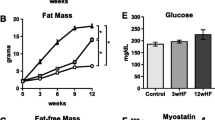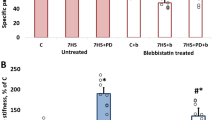Abstract
We analyzed the signaling processes initiating proteolytic events in the human soleus muscle during short-term exposure under the non-weight-bearing conditions. Dry immersion (DI) was used to induce weight deprivation in the m. soleus for 3 days. Western blotting was used to determine the level of insulin receptor substrate 1 (IRS-1), total and phosphorylated neuronal NO synthase (nNOS), and adenosine monophosphate-activated protein kinase (AMPK), which control the anabolic and catabolic signaling pathways, and the level of cytoskeletal protein desmin and Са2+-activated protease calpain. By day 3 of DI, calpain- dependent proteolysis manifests itself by reductions in both the total content and level of nNOS phosphorilation. The rate of AMPK phosphorylation was significantly decreased.
Similar content being viewed by others
References
Kozlovskaya, I.B., Dmitrieva, L., Grigorieva, L.S., et al., Gravitational mechanisms in the motor system. Studies in real and simulated weightlessness, in Stance and Motion: Facts and Concepts, Gurfinkel, V.S., Ioffe, M.E., and Massion, J., Eds., New York: Springer-Verlag, 1988, pp. 37–48.
Kozlovskaya, I.B., Grigorieva, L.S., Gevlich, G.I., et al., Comparative analysis of the weightlessness and its simulations effects on the force-velocity properties and tone of human skeletal muscles, Kosm. Biol. Aviakosm. Med., 1984, vol. 18, no. 6, pp. 22–26.
Shenkman, B.S., Nemirovskaya, T.L., Shcheglova, I.A., et al., Morphological characteristics of human m. vastus lateralis in supportlessness, Dokl. Ross. Akad. Nauk, 1999, vol. 364, no. 4, pp. 563–565.
Navasiolava, N.M., Custaud, M.-A., Tomilovskaya, E.S., et al., Long-term dry immersion: review and prospects, Eur. J. Appl. Physiol., 2011, vol. 111, no. 7, pp. 1235–1260.
Litvinova, K.S., Vikhlyantsev, I.M., Kozlovskaya, I.B., et al., Effects of artificial support stimulation on fiber and molecular characteristics of soleus muscle in men exposed to 7-day dry immersion, J. Gravitational Physiol., 2004, vol. 11, no. 2, pp. 131–132.
Moukhina, M., Shenkman, B.S., Blottner, D., et al., Effects of support stimulation on human soleus fiber characteristics during exposure to “dry” immersion, J. Gravitational Physiol., 2004, vol. 11, no. 2, pp. 137–138.
Ogneva, I.V., Ponomareva, E.V., Kartashkina, N.L., et al., Decrease of contractile properties and transversal stiffness of single fibers in human soleus after 7-day “dry” immersion, Acta Astronaut., 2011, vol. 68, pp. 1478–1485.
Mitarai, G., Mano, T., Mori, S., and Jijiwa, H., Electromyographic study on human standing posture in experimental hypograve state, Annu. Rep. Res. Inst. Environ. Med., Nagoya Univ., 1972, vol. 19, pp. 1–9.
Miller, T.F., Saenko, I.V., Popov, D.V., et al., Effect of mechanical stimulation of the support zones of soles on the muscle stiffness in 7-day dry immersion, J. Gravitational Physiol., 2004, vol. 11, no. 2, pp. 135–136.
Kirenskaya, A.V., Kozlovskaya, I.B., and Sirota, M.G., Influence of the immersion hypokinesia on the characteristics of the rhythmic activity of soleus motor units, Fiziol. Chel., 1986, vol. 12, no. 1, pp. 617–632.
Kawano, F., Ishihara, A., Stevens, J.L., et al., Tensionand afferent input-associated responses of neuromuscular system of rats to hindlimb unloading and/or tenotomy, Am. J. Physiol.-Regul. Integr. Comp. Physiol., 2004, vol. 287, no. 1, pp. R76–86.
Ingalls, C.P., Warren, G.L., and Armstrong, R.B., Intracellular Ca2+ transients in mouse soleus muscle after hindlimb unloading and reloading, J. Appl. Physiol., 1999, vol. 87, no. 1, pp. 386–390.
Ingalls, C.P., Wenke, J.C., and Armstrong, R.B., Time course changes in [Ca2+]i, force, and protein content in hindlimb-suspended mouse soleus muscles, Aviat. Space Environ. Med., 2001, vol. 72, no. 5, pp. 471–476.
Shenkman, B.S. and Nemirovskaya, T.L., Calciumdependent signaling mechanisms and soleus fiber remodeling under gravitational unloading, J. Muscle Res. Cell. Motil., 2008, vol. 29, pp. 221–230.
Enns, D.L. and Belcastro, A.N., Early activation and redistribution of calpain activity in skeletal muscle during hindlimb unweighting and reweighting, Can. J. Physiol. Pharmacol., 2006, vol. 84, pp. 601–609.
Enns, D.L., Raastad, T., Ugelstad, I., and Belcastro, A.N., Calpain/calpastatin activities and substrate depletion patterns during hindlimb unweighting and reweighting in skeletal muscle, Eur. J. Appl. Physiol., 2007, vol. 100, no. 4, pp. 445–455.
Ogneva, I.V., The transversal stiffness of fibers and the desmin content in the leg muscles of rats under gravitational unloading of various duration, J. Appl. Physiol., 2010, vol. 109, no. 6, pp. 1702–1709.
Michetti, M., Salamino, F., Melloni, E., and Pontremoli, S., Reversible inactivation of calpain isoforms by nitric oxide, Biochem. Biophys. Res. Commun., 1995, vol. 207, no. 3, pp. 1009–1014.
Samengo, G., Avik, A., Fedor, B., et al., Age-related loss of nitric oxide synthase in skeletal muscle causes reductions in calpain S-nitrosylation that increase myofibril degradation and sarcopenia, Aging Cell, 2012, vol. 11, no. 6, pp. 1036–1045.
Tidball, J.G., Lavergne, E., Lau, K.S., et al., Mechanical loading regulates NOS expression and activity in developing and adult skeletal muscle, Am. J. Physiol., 1998, vol. 275, pp. 260–266.
Sandonà, D., Desaphy, J.F., Camerino, G.M., et al., Adaptation of mouse skeletal muscle to long-term microgravity in the MDS mission, PLoS One, 2012, vol. 7, no. 3, p. e33232.
Rudnick, J., Püttmann, B., Tesch, P.A., et al., Differential expression of nitric oxide synthases (NOS 1–3) in human skeletal muscle following exercise countermeasure during 12 weeks of bed rest, FASEB J., 2004, vol. 8, no. 11, pp. 1228–1230.
Sun, L.W., Blottner, D., Luan, H.Q., et al., Bone and muscle structure and quality preserved by active versus passive muscle exercise on a new stepper device in 21 days tail-suspended rats, J. Musculoskeletal Neuronal Interact., 2013, vol. 13, no. 2, pp. 166–177.
Lomonosova, Yu.N., Kalamkarov, G.R., Bugrova, A.E., Shevchenko, T.F., Kartashkina, N.L., Lysenko, E.A., Shenkman, B.S., and Nemirovskaya, T.L., Role of NO-synthase in regulation of protein metabolism of stretched rat m. soleus muscle during functional unloading, Biochemistry, 2012, vol. 77, no. 2, pp. 208–216.
Lainé, R. and de Montellano, P.R., Neuronal nitric oxide synthase isoforms alpha and mu are closely related calpain-sensitive proteins, Mol. Pharmacol., 1998, vol. 54, no. 2, pp. 305–312.
Crosbie, R.H., Barresi, R., and Campbell, K.P., Loss of sarcolemma nNOS in sarcoglycan-deficient muscle, FASEB J., 2002, vol. 16, no. 13, pp. 1786–1791.
Chen, Z.P., McConell, G.K., Belinda, J., et al., AMPK signaling in contracting human skeletal muscle: acetyl-CoA carboxylase and NO synthase phosphorylation, Am. J. Physiol. Endocrinol. Metab., 2000, vol. 279, pp. E1202–1206.
Hinchee-Rodriguez, K., Garg, N., Venkatakrishnan, P., et al., Neuronal nitric oxide synthase is phosphorylated in response to insulin stimulation in skeletal muscle, Biochem. Biophys. Res. Commun., 2013, vol. 435, no. 3, pp. 501–505.
Nakao, R., Hirasaka, K., Goto, J., et al., Ubiquitin ligase Cbl-b is a negative regulator for insulin-like growth factor 1 signaling during muscle atrophy caused by unloading, Mol. Cell Biol., 2009, vol. 29, no. 17, pp. 4798–811.
Murphy, R.M., Verburg, E., and Lamb, G.D., Ca2+ activation of diffusible and bound pools of μ-calpain in rat skeletal muscle, J. Physiol., 2006, vol. 576, no. 2, pp. 595–612.
Hayot, M., Michaud, A., Koechlin, C., et al., Skeletal muscle microbiopsy: a validation study of a minimally invasive technique, Eur. Respir. J., 2005, vol. 25, pp. 431–440.
Sánchez-Ruiloba, L., Aicart-Ramos, C., García-Guerra, L., et al., Protein kinase D interacts with neuronal nitric oxide synthase and phosphorylates the activatory residue Serine1412, PLoS One, 2014, vol. 9, no. 4, p. e95191.
Han, B., Zhu, M.J., Ma, C., and Du, M., Rat hindlimb unloading down-regulates insulin like growth factor-1 signaling and AMP-activated protein kinase, and leads to severe atrophy of the soleus muscle, Appl. Physiol. Nutr. Metab., 2007, vol. 32, no. 6, pp. 1115–1123.
Hilder, T.L., Baer, L.A., Fuller, P.M., et al., Insulinindependent pathways mediating glucose uptake in hindlimb-suspended skeletal muscle, J. Appl. Physiol., 2005, vol. 99, no. 6, pp. 2181–2188.
Ruderman, N.B., Keller, C., Richard, A.M., et al., Interleukin-6 regulation of AMP-activated protein kinase. Potential role in the systemic response to exercise and prevention of the metabolic syndrome, Diabetes, 2006, vol. 55, no. 2, pp. 48–54.
Hardie, D.G. and Ashford, M.L., AMPK: regulating energy balance at the cellular and whole body levels, Physiology (Bethesda), 2014, vol. 29, no. 2, pp. 99–107.
Author information
Authors and Affiliations
Corresponding author
Additional information
Original Russian Text © N.A. Vil’chinskaya, T.M. Mirzoev, Yu.N. Lomonosova, I.B. Kozlovskaya, B.S. Shenkman, 2016, published in Aviakosmicheskaya i Ekologicheskaya Meditsina, 2016, Vol. 50, No. 1, pp. 28–34.
Rights and permissions
About this article
Cite this article
Vil’chinskaya, N.A., Mirzoev, T.M., Lomonosova, Y.N. et al. Effect of Short-term Dry Immersion on Proteolytic Signaling in the Human Soleus Muscle. Hum Physiol 43, 787–792 (2017). https://doi.org/10.1134/S0362119717070209
Received:
Published:
Issue Date:
DOI: https://doi.org/10.1134/S0362119717070209




